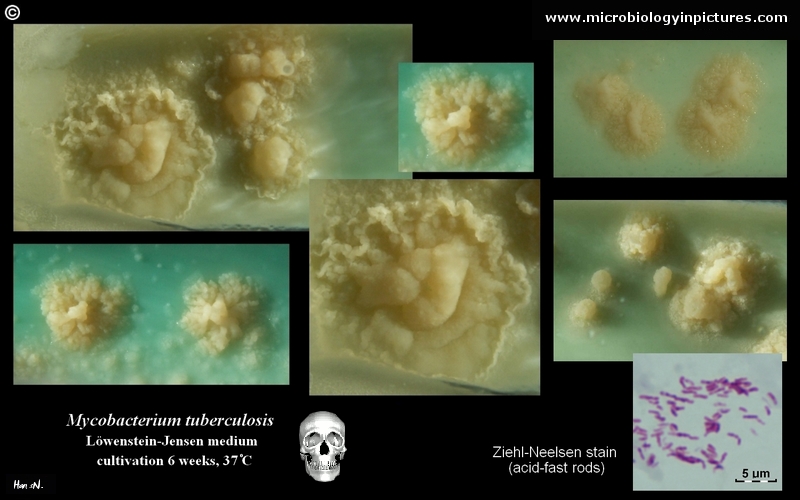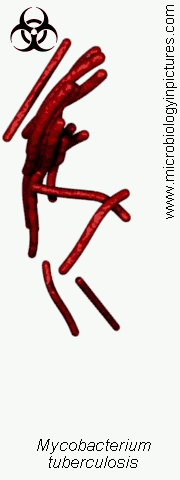Mycobacterium tuberculosis


Mycobacterium tuberculosis on Löwenstein-Jensen medium after 6 weeks of cultivation, 37°C. Typical nonpigmented, rough, dry colonies on Löwenstein-Jensen medium. The green color of the medium is due to the presence of malachite green which is one of the selective agents to prevent growth of most other contaminants. Unlike many other solid cultivation media used in clinical microbiology Löwenstein-Jensen medium (or e.g., Ogawa medium) doesn't contain any agar (solid consistence is attained by heat coagulation of the egg albumin).
Mycobacterium tuberculosis (MTB) is a pathogenic bacterial species in the genus Mycobacterium and the causative agent of most cases of tuberculosis. First discovered in 1882 by Robert Koch, M. tuberculosis has an unusual, waxy coating on the cell surface (primarily mycolic acid), which makes the cells impervious to Gram staining; acid-fast techniques are used instead. The physiology of M. tuberculosis is highly aerobic and requires high levels of oxygen. Primarily a pathogen of the mammalian respiratory system, MTB infects the lungs, causing tuberculosis.
M. tuberculosis requires oxygen to grow. It does not retain any common bacteriological stain due to high lipid content in its wall, and thus is neither Gram-positive nor Gram-negative; hence Ziehl-Neelsen staining, or acid-fast staining, is used. While Mycobacteria do not seem to fit the Gram-positive category from an empirical standpoint (i.e., they do not retain the crystal violet stain), they are classified as acid-fast Gram-positive bacteria due to their lack of an outer cell membrane.
M. tuberculosis divides every 15-20 hours, which is extremely slow compared to other bacteria, which tend to have division times measured in minutes (Escherichia coli can divide roughly every 20 minutes). Its unusual cell wall, rich in lipids (e.g., mycolic acid), is likely responsible for this resistance and is a key virulence factor. When in the lungs, M. tuberculosis is taken up by alveolar macrophages, but they are unable to digest the bacterium. Its cell wall prevents the fusion of the phagosome with a lysosome. Specifically, M. tuberculosis blocks the bridging molecule, early endosomal autoantigen 1 (EEA1); however, this blockade does not prevent fusion of vesicles filled with nutrients. Consequently, the bacteria multiply unchecked within the macrophage.
Cultivation
M. tuberculosis is grown on a selective medium known as Löwenstein-Jensen medium, which has traditionally been used for this purpose. However, this method is quite slow, as this organism requires 6-8 weeks to grow (growth of isolated colonies in more than 7 days), which delays reporting of results. A faster result can now be obtained using Middlebrook medium or BACTEC.
Mycobacterium tuberculosis basic characteristics
- ACID-FAST RODS
- NONMOTILE
- NON-SPORE-FORMING
- CATALASE: POSITIVE**
- OXIDASE: NEGATIVE
- AEROBES
** some isoniazid-resistant strains of M.tuberculosis may be negative
Identification of Mycobacterium tuberculosis
- Slow growing mycobacteria (growth of isolated colonies in more than 7 days)
- Nonpigmented, rough, dry colonies on Löwenstein-Jensen medium
- Acid-fast (Ziehl-Neelsen or Kinyoun stain)
- Nonphotochromogenic
- The niacin test: positive
- The nitrate reduction test: positive
- Growth on TCH (thiophene-2-carboxylic acid hydrazide); 10µg/ml: positive, TCH resistant (unlike M.bovis)
- Growth on pyrazinamidase agar (PZA); 25µg/ml: negative
- The arylsulfatase test (3-Day test): negative
Treatment of Mycobacterium tuberculosis
Susceptibility testing at least for INH, RIF, and EMB should be always performed!! Drugs are not used singly!! (Why?)-
First-line drugs
- Isoniazid (INH)
- Ethambutol (EMB)
- Pyrazinamide (PZA)
- Rifampicin (Rifampin) (RMP/RIF)
- Streptomycin** (SM/STM)
** In the US only, streptomycin is no longer considered a first line drug by ATS/IDSA/CDC because of high rates of resistance.
Second-line drugs (examples)
The second line drugs are only used to treat disease that is resistant to first line therapy
- amikacin (aminoglycosides)
- kanamycin (aminoglycosides)
- ciprofloxacin (quinolones)
- cycloserine For more visit Wikipedia
The standard "short" course treatment for TB is isoniazid (along with pyridoxal phosphate to obviate peripheral neuropathy caused by isoniazid), rifampicin (rifampin in the United States), pyrazinamide, and ethambutol for two months, then isoniazid and rifampicin alone for a further four months. The patient is considered to be free of living bacteria after six months (although there is still a relapse rate of up to 7%).
Mycobacterium tuberculosis on Löwenstein-Jensen medium

















Mycobacterium tuberculosis cultivation


Mycobacterium sp.






Acid-fast stain (Ziehl-Neelsen & Kinyoun's stain)









Mycobacterium tuberculosis SEM & 3D illustrations



Useful Links
WIKIPEDIACENTERS FOR DISEASE CONTROL AND PREVENTION (CDC)
- Basic TB Facts
- Testing & Diagnosis
- Testing for tuberculosis (TB)
- Treatment of Tuberculosis; American Thoracic Society, CDC, and Infectious Diseases Society of America
- Acid-fast stain
MICROBE LIBRARY
